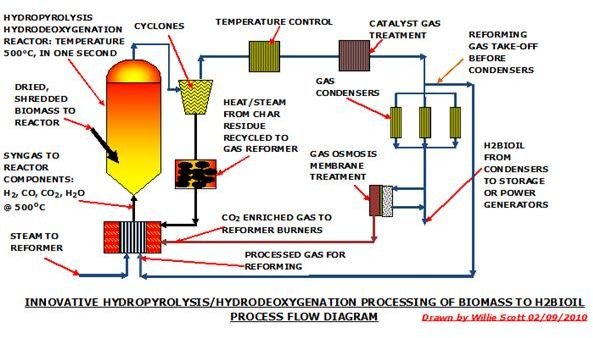Mobile Biomass Processing Plants - Go to Where the Biomass Wastes or Crops Are
Introduction to Mobile Biomass Crop or Waste Processing
An innovative method of processing gas from biomass has been developed by engineers at the University of Purdue. This fast pyrolysis method uses hydrogen to attain high temperatures in minutes inside a high pressure reactor, which increases the yields as well as the type of biomass that can be used as feedstock. They hope to be able to scale this system down to make it mobile and visit farms, using their biomass to produce a new liquid biofuel known as H2bioil.
This is an article on biofuels, and in particular biofuel from farm waste using this new reactor and system. We begin with an overview of a current reactor and then move on to the new technology.
Overview of Processing Biofuel using a Conventional Reactor
We shall look first at a conventional circulating fluid bed type reactor that can use a variety of biomass feedstock.
The biomass is dried and shredded before being fed into a reactor; through the top, middle, or just above the bottom layer of sand. Meanwhile, compressed air and/or steam is being blown through the bed of sand which is laid along the bottom of the reactor, its purpose being to ensure optimum mixing of feed, gas, and hot-bed material. The bed material swirls upwards and mixes with the biomass; being recovered and returned to the bed area through a canopy inside the reactor and a chute on the outside.
As the biomass falls through the combustion area, it is subjected to high temperature produced by oxygen burners and is converted to char with gaseous compounds. The gases rise and are ejected out the top of the reactor, where they are piped to a cyclone which separates and removes the ash and sand particles.
The gas now passes through various processes of cooling and catalytic treatments, producing an end product of biogas.
Reference Web: alexandria - pyrolysis reactor info.
Processing Biomass Using the Fast Hydropyrolysis Hydrodeoxygenation Method
As we have seen this fast pyrolysis method was developed at Purdue University and is described below.
The feed stock is dried and shredded before being fed into a vertical high pressure and temperature steel reactor. The particular pyrolysis reactor is cylindrical being domed at the top and pointed at the bottom, joined by a parallel section in the centre.
The syngas is injected from the bottom, the biomass also being fed into this area from above, combusting almost immediately to char and gas in temperatures of around 900°F.
The syngas is produced initially by reforming natural gas; until the system is producing its own gas then this is used. As well as containing a high proportion of hydrogen, the syngas also contains CO, CO2, and H2O and is injected to the base of the reactor at around 900F.
The gasses produced by pyrolysis rise up the reactor, exiting at the domed top and feeding into a cyclone. Here the residual char is removed and sent to a combustor from where the heat and steam is directed to the reformer as additional heat input.
Meantime the gasses have passed through a temperature controller to cool them to around 350°C, before being fed through the hydrodeoxygenation (HDO) catalyst treatment section, with sulfate iron oxide being a typical catalyst used to reduce the oxygen content of the gas.
The gas is now split to be fed to the reformer to be reformed to syngas, and piped through a series of condensers which convert the gas to liquid fuel known as H2bioil. This oil is passed through an osmosis membrane, producing a high CO2 content gas for the reformer burners, and the H2bioil is pumped to storage.
So now we have the gas for reforming and the gas to use as fuel in the reforming process.
The reformed gas (Syngas) as previously stated is hydrogen rich containing CO,CO2, and H2O components at a temperature of 900°F.
Referenced Webs:
1. sciencedaily - mobile biomass crops or waste processing proposed.
2. purde - the development of fast-hydropyrolysis-hydrodeoxygenation of biomass.
3. pubsacs - catalysts (feS), oxygen removal from gas streams
Mobile Biomass Crop or Waste Processing.
As we have seen, the chemical engineers at the Purdue University are working on a mobile version of the plant. We can only speculate as to the magnitude of the unit, but looking at size of some container trucks on the road, these mobile units should be capable of containerization.
The following points spring to mind regarding mobile biomass processing unit:
- Access roads to the farm should be checked as well as a working area.
- The farmer should be given approximate dates of the arrival of the unit at his farm.
- Water will be needed for the condensers – is there an available supply.
- It may be beneficial to supply the farmers with shredders and dryers. He could then have a stock of biomass prepared for the arrival of the unit.
- If the produced oil is suitable without further processing for use in a gas engine, the farmer may find it beneficial to install a gas storage tank and genset to supply his own electricity.
Reference Web: sciencedaily - mobile biomass crops or waste processing proposed.
Image Section: Sketches of Conventional Fluid-Bed Reactor and, New Fast Hydropyrolysis Hydrodeoxygenation Reactor.

